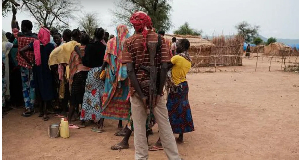India don ready to overtake China to become di most populous kontri for di world by di middle of dis year according to di data wey di United Nations show.
India population dey expected to reach 1.4286 billion - 2.9 million more dan im neighbour wey dey on 1.4257 billion.
Di Asian nations don account for more dan a third of di global population for over 70 years.
China birth rate don reduce recently with im population wey shrink last year for di first time since 1961.
India population forecast wey dey di United Nations Population Fund (UNFPA) State of World Population report na estimate since census never hapun for di kontri since 2011.
After 140 years of uninterrupted census every 10 years, dem cancel di 2021 census because of Covid and postpon am to 2022. Now, dem don again push am back to 2024.
Inside interview with BBC, UN Chief of Population Estimates and Projection, Patrick Gerland, say any number about India real population size na "naïve assumptions wey dey based on fragmental information".
"We no get real official data wey dey come out from India", e tok.
Also, UN say dia estimate no include di population of China two Special Administrative Regions - Hong Kong and Macau, wey together get more dan 8 million pipo - or di island of Taiwan, wey Beijing see as a breakaway province wey go unify with di mainland one day. Taiwan dey see imsef as separate from di Chinese mainland, with im own constitution and democratically-elected leaders.
For November, di global population cross 8 billion. But experts say growth no fast like before and now, e dey at its slowest rate since 1950.
Both India and China don see reduction for dia fertility rates. E mean say for China, di population go start to dey reduce next year, despite say di kontri abandon im one-child policy for 2016 and introduce tins to ginger couples to born two or more children.
Rising living costs and di increase in di number of women wey dey join di workforce dey among oda factors wey dem dey blame for the slowdown for China.
For India, too, fertility rates don fall well-well in recent decades from 5.7 births per woman for 1950 to 2.2 births per woman today.
One survey wey UNFPA commission show say majority of Indians say dia population dey too large and fertility rates dey too high. Almost two in three respondents identify economic issues as top concerns wen dem dey tink about population growth.
Demographers, however, say India population overtaking China own no suppose dey seen as a mata of concern and caution against worry over di rising numbers.
"Instead, e suppose dey seen as a symbol of progress, development, and aspirations if dem don dey uphold individual rights and choices," di UN report tok.
Additional reporting by Ricardo Senra, Global Population correspondent
BBC Pidgin of Wednesday, 19 April 2023
Source: BBC
















